► Ferrari battles McLaren and Audi for the top spot
► Can Audi’s naturally aspirated V10 swing the deal?
► Sublime contenders, but only one can triumph…
The road’s dry, its surface bleached with cappuccino smears of late-winter grime. Ahead, corners stretch out traffic-free, so I push the McLaren 570S’s accelerator to its stop, let the car run wide for the fastest line, the others darting behind. The sun flares through a swimming-pool sky as hungry induction plenums gobble chill air, and dual-clutch gearboxes hammer ratios like a drummer counting in a 4/4 beat.
I glance in the mirror, cast an eye over the McLaren’s hard-working twin-turbo V8, see the red flash of the Ferrari 488 GTB, the piercing yellow of the Audi R8 V10 Plus, daytime running lights locked on like snipers’ lasers. The others must be sniffing victory as they close on the least powerful car, but already the McLaren’s making a bid for the spoils: the tactility, agility, communication and, yes, pure speed. The 570S will be no easily picked off runt of the litter.
This incredible car is proof of how far McLaren has progressed in five years, from being initially blindsided by objective numbers to letting subjective feel take the wheel. But no matter how impressive McLarens have become, there’s one inescapable truth: when they go head-to-head with Ferrari, they typically lose.
With the 570S, McLaren has planted a flag where Ferrari has yet to venture: the 570S forms part of McLaren’s new Sports Series, a mid-engined V8 supercar for £143k. Take that money to Ferrari and they’d talk you up to a folding hardtop for £155k, yet the 570’s spec is a facsimile of the 650S, McLaren’s true 488 rival. Has McLaren caught Ferrari napping with a similar concept for £40k less? We’ve two days to find out.
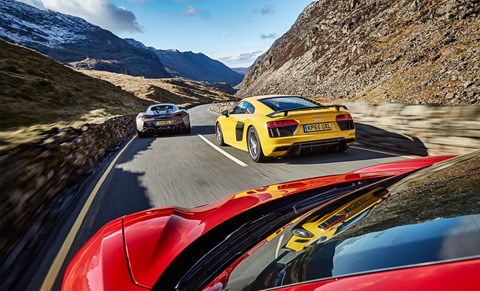
Not that McLaren has the £140k supercar market wrapped up: long before McLaren trumpeted its day-to-day usability over the more frenetic Ferrari, Audi nailed it with the R8. And when I get to pick a car to drive over dark, wet roads from the East Midlands to North Wales, I don’t hesitate.
Like all returning blockbusters, the Audi R8 sequel doesn’t mess too much with the formula: there’s no V8 this time, no open-gate manual, but the styling is so gently evolutionary that Darwin himself might not record it, the all-wheel-drive fundamentals remain, so too the V10. The purveyors of Vorsprung Durch Technik, shoving an old-school Lamborghini 5.2-litre V10 in the back of a new car? Did the memo fall into the VW Group shredder? Isn’t everyone downsizing and turbocharging because emissions regulations are forcing their hands?
There’s an almost orchestral quality to the V10, a percussive bassiness at low rpms that soars to the high-pitched strings of the redline and what sounds like a successful Gunpowder Plot on the overrun in Dynamic mode; it’s mechanical and sonorous, and zings with a response that makes a firearms unit look slack.
413lb ft at 6500rpm might suggest a hole in the power delivery down low, but accelerate from 1500rpm in second or third and the revs spin so quickly you’ve a job to count the numbers on the dial, the delivery stretching out linearly like elastic until – somewhere around 5500rpm (I was busy!) – there’s even moreurgency, like someone’s fast-forwarded you to the 8250rpm head-rush. Pity the transmission sometimes dithers when you suddenly floor it, like it’s channelling the Gallardo’s old-school automated manual, and high-rpm shifts lack what the Germans call ‘emotion’.
Tonight, mostly, I wind back the pace, but even at a cruise you notice the Audi’s improved front-end response. Twist the flat-bottomed steering rim and the front jinks like one solid piece; no slop, no time delay, just one cohesive transition to where your hands are pointing.
Our test car gets optional Dynamic steering, perhaps that’s key, but there’s no doubting the responsiveness owes much to the stiff Audi Space Frame. Aluminium dominates, but carbonfibre forms the transmission tunnel and rear bulkhead like a spine and broad shoulders. Even commuting, the underlying rigidity is tangible.
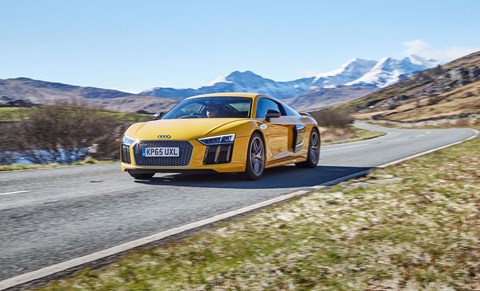
Over the A14, I settle back into the optional sports seats, pneumatic bolsters squeezing my frame just so, 6 Music belting from £1750’s worth of B&O audio. The low-slung driving position, the quality of the materials, and the deep, low scuttle is déjà vu, and yet so much has changed. The steering wheel now takes a leaf out of Ferrari’s manual, allowing you to switch between driving modes and activate the sports exhaust without letting go of the wheel. But there are also – unlike the Ferrari – infotainment functions integrated in the spokes. It’s busier than the M25, but it works.
Three hours slip by, adaptive suspension (optional!) absorbing bumps, 602bhp picking off traffic in effortless surges, and the brilliant Virtual Cockpit either filling the TFT instrument binnacle with high-resolution satellite-navigation, or bringing speed and rpms to the fore; neither Ferrari nor McLaren does tech like this.
When the roads tangle into twists, the R8’s sure-footed handling combines with relatively modest torque to make this a car you can stroke cross-country in confidence and safety at speed. But it’s the thrill of the drive that’ll stay in my mind long after the metal’s stopped pinging, especially the way you can pick up the power early and feel the front tyres pull you from the curve with unruffled composure in a flurry of speed. The suspension and steering even works in Dynamic mode this time, rather than filling the tyres with cement.
Fatigue slain by adrenaline, I reach our stopover, grab a beer to come down, and ponder if you can actually better the Audi’s blend of driver enjoyment, safety and high-tech infotainment; if you use your supercar regularly, I doubt you can.
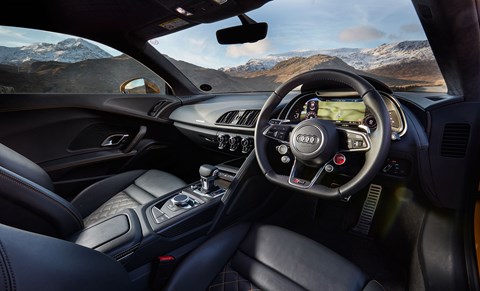
Outside, the Ferrari’s flat-plane crank settles to a constant, bassy idle, and a minute later in walks James Taylor. The stability control’s been working overtime, snuffing out slides before they even started, he says. CJ Hubbard’s had an easier time of it, the McLaren’s Pirelli SottoZero winter tyres melding with the surface as temperatures plummeted. The next day that advantage should melt: double-digit temperatures are forecast.
But at 7.30am the Ferrari’s still coated in a thin veil of frost like a monarch shrouded in a chrysalis. It’s very conditions-sensitive, the Ferrari, which doesn’t surprise with 661bhp and 561lb ft. Even at 4degC on dry roads, it feels edgy on its Michelin Pilot Super Sports, engineered around its trick stability control. So I settle in, steel myself for the warmer temperatures later that day.
85% of parts are new compared with the 458 Italia, but there’s no mistaking where you are when you drop low into those firm sports seats. I particularly like how everything – scalene air vents, intricately contoured steering wheel, peripheral infotainment and vehicle displays – train your vision towards the central rev counter like a burst of light at the end of tunnel.
That rev counter might still read to ten grand, but it’s now redlined 1k earlier at just over 8000rpm because the 458’s 4.5-litre V8 makes way for an all-new 3.9-litre V8 twin-turbo. It’s a masterpiece. Throttle response is instant, turbo lag non-existent, and the revs quickly taper away when you back off. It even sounds fantastic, that droney idle becoming a familiar Ferrari bwooooor towards the redline. Low in the mix, you hear the turbos subtly blowing like breakers hitting the shore.
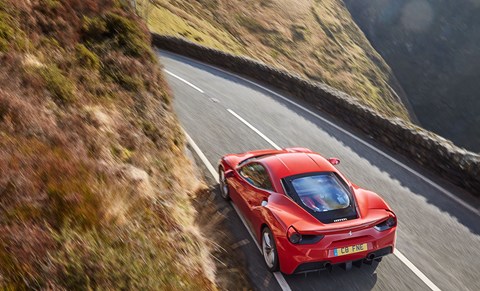
The really clever part is Variable Torque Management: instead of the 488 giving you all 561lb ft in the low-to-mid-range as you’d expect, Ferrari drip-feeds it, encouraging you to use the revs. The seven-speed dual-clutch gearbox is familiar and continues to consume ratios like a schoolkid flicking lugs on a bus, but the ratios are a little longer. Had they not been, the 488’s massive extra mid-range and lower peak power would have had you nutting the limiter constantly. You might ping off the redline a couple of times, but mostly you’ve got so much mid-range, so much speed and still so much headroom that you rarely do. It’s a great powertrain.
When the mercury hits 8degC, I head out for a faster drive. You notice the steering’s a little firmer than the 458 Italia’s, with more road-surface fizz too, but it’s still super-quick, and this time its keenness to change direction just feels immediately natural, not shockingly darty like the 458 did if you’d just stepped from a humdrum hatch; is that familiarity over the years on my part, or is the 488 somehow better sorted?
The R8 felt light and keen to switch direction in isolation, but already the 488 shades it. The purity with which the Ferrari shadow boxes through bends, up on its toes, only highlights that the Audi turns and drives at least partly with the fronts; the slight understeer the R8 generates under power might ping you out of roundabouts unbelievably quickly, but it does introduce a lethargy to direction changes.
Despite the Ferrari’s massive slug of torque – and because of Variable Torque Management – traction is actually very good, Michelins keying in and letting go progressively when they can take no more. When rear treadblocks do squirm, the traction control almost imperceptibly covers your talent deficit. Pray for owners who learn to drive a supercar on this basis, then disable everything; they’ll make Ken Block outtakes look as lairy as the Queen being chauffeured to the Cenotaph.
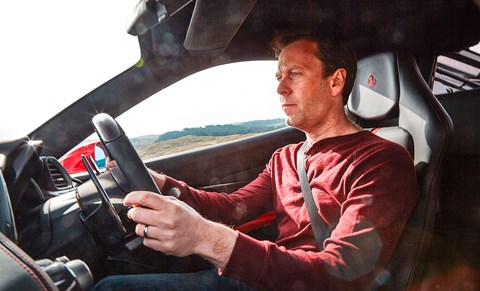
I gradually work my way round the manettino dial, tweaking the gearbox, engine, ABS and safety settings, finally building the nerve to go ESC Off. Three shrill beeps ring out, presumably covering the Italian expletives the fandango’s trying to hurl at you.
Where the 488 had felt flighty at 4degC, at 8degC it’s totally dialled in. The front tyres are half-an-inch wider than a 458’s, and while at first you lean on the excellent carbon-ceramic brakes early – shared with LaFerrari, but missing the strange pedal feel caused by the hybrid powertrain – soon you learn to carry speed into the corner, feel the suspension compress a little, then just rollercoaster right through the bend, understeer absent from the lexicon.
With the front biting hard and loaded up, you’re free to climb on the fast pedal, and still you sense those reserves of traction, the progressive slip into oversteer. ‘Wow!’ says CJ later, stepping from the 488 and pointing at it. ‘The R8 is a sports car. That is a supercar!’
Hamstrung by winter tyres, I wait for temperatures to dip before driving the McLaren. McLaren says the 570S is more liveable than its serenely supple 650S, and has even re-engineered the MonoCell with 80mm lower sills, so you no longer sneak through the gap in the open dihedral doors like Frankenstein struggling into the bottom bunk.
The McLaren’s steering wheel is starkly naked after the others, and you sit forwards and low down, the view through the windscreen unobstructed like a fighter-jet canopy. Even at very low speeds the McLaren communicates that it’s light and agile, that there’s no fear in taking liberties. The stiff, lightweight carbonfibre structure feels totally cohesive, the electro-hydraulic steering crackles with information, and even the dainty hips play a part, helping you thread the car through gaps that squeeze the others.
I’m not a natural left-foot braker, but the McLaren presents its brake pedal so perfectly to your unemployed limb that it feels rude to refuse. Doing the same in the Audi is like trying to pedal a penny-farthing, so high and offset are accelerator and brake. Even with my desensitised hoof, I learn to push through the McLaren’s minimal slack and feed off the building pressure coming up through the pedal, trusting the endless reserves of the – standard – carbon-ceramics.
I build up the speed, heading to my favourite road, all fast flicks, open-sighted sweepers and zero traffic, setting the handling and powertrain modes to Sport and deactivating the stability control because it cuts in too easily. You quickly find a rhythm with the McLaren. The steering both constantly jiggles in your hands and lets you place the front tyres with laser-guided accuracy, and there’s so much dialogue with the surface that cats’ eyes bang up through the carbon structure like plod knocking at the door; it might sound uncouth, but you’re just getting constant unfiltered messages from a very supple car. ‘It feels how you’d imagine a Lotus supercar would,’ comments James Taylor. Spot on.
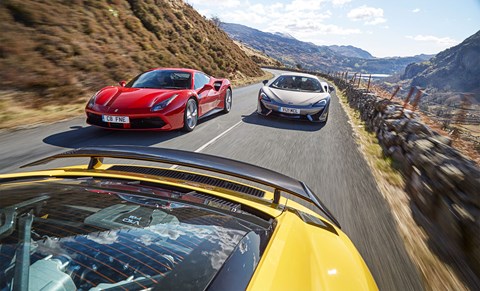
You might think testing the 570S on winter tyres unfair, and at times they are a liability, squidging under braking, writhing like jelly through esses. But I’ve also driven a McLaren on the standard P-Zero Corsas, a pretty aggressive tyre (regular P-Zeros are a no-cost option), and it felt incredible. There’s no understeer, bags of traction, and the way the body stays flat and you skim through corners in one fluid movement is awesomely compelling. You can even revel in sliding the 570, such is its poise and balance. As a way of making shocks and springs and brakes entertain their driver, the McLaren is definitely a match for the Ferrari.
Where Maranello really monsters Woking is with the powertrain. The McLaren’s gearshifts are quick – and certainly more incisive and obedient than the 12C once was – but the Ferrari’s are significantly punchier, trimming slack from the man/machine interface; and the Ferrari’s shift paddles – fixed to the column, not the wheel like the McLaren’s – engage with a shorter click, and feel nicer too.
McLaren’s 3.8-litre V8 has an ample 562bhp and 443lb ft, but this is a much more conventional-feeling turbo engine, laggy down low, with a soggier pedal and a noticeable – if thrilling – turbo hit at just gone 3000rpm, not the Ferrari’s eerie progression. The last 570S I drove had the optional sports exhaust, bringing a hard mechanical edge. With the standard pipes, this 570 sounds gruff, even tractor-like at low rpms. Tick that exhaust box.
Negatives fall by the wayside when you find yourself on an open road, the lag that maybe frustrated through slower kinks no longer an issue. You start to revel in the upper reaches of the McLaren’s flexible delivery, and the soundtrack becomes more goose-pimple industrial the higher the revs climb. You keep the revs and speed high, cutting cross-country, feeling the suspension breathe beneath you, confident that you can use all the power, all the time.
There’s no denying the 570S has so much right when it comes to driver feedback and enjoyment. It doesn’t even feel like it lacks power in this company, proving that you really don’t need Ferrari horses to have riotous fun. What’s absent is the Ferrari’s powertrain response.
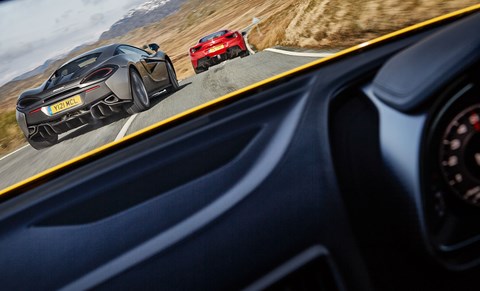
When we park up for our closing shot, there’s no debate that the Ferrari wins. But the fact that the McLaren 570S delivers much of the thrill of the 488 GTB for £46k less – or almost £70k when both these cars’ lavish options are tallied – weighs heavily on the result. The 570S is a deeply exciting and communicative drive, a sports car that steers like a supercar and offers huge savings over its Italian rival from the class above. Just imagine if Ferrari stepped down to the McLaren’s level with a new V6 Dino; then we’d have a proper scrap on our hands. Today, the McLaren can hold its head high with a strong second.
That the Audi slips into third place is testament to the quality of this group, not a particular failing on its part. It’s the cheapest car here, packs a firecracker of an engine, and melds sensational dynamics with the most useable ownership proposition of the bunch. If you need one supercar to do everything, buy the Audi.
Right now, tank brimmed, sun setting, roads clear and dry, I’m getting another fix in the Ferrari.
The result
1st – Ferrari 488 GTB: Even when handicapped by a cartoonish pricetag the 488 monsters all before it. So many superlatives, so little time.
2nd – McLaren 570S: It’s a case of arise, sir McLaren: you have well and truly arrived. The 488 has everything in its favour, yet it was so close.
3rd – Audi R8 V10 Plus: Not a defeat but a victory for the notion of the all-weather, everyday supercar. Every day? Yep, and every one will be epic.
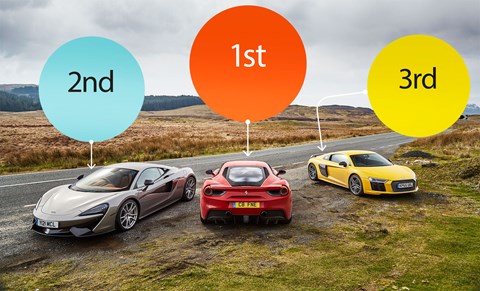
Video verdict
Facts and figures
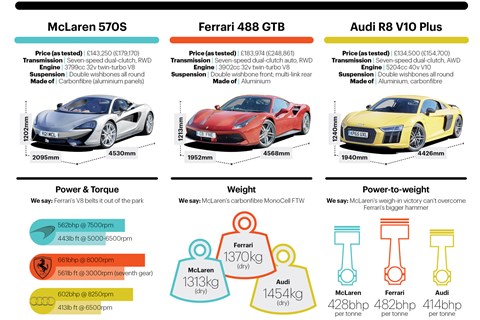
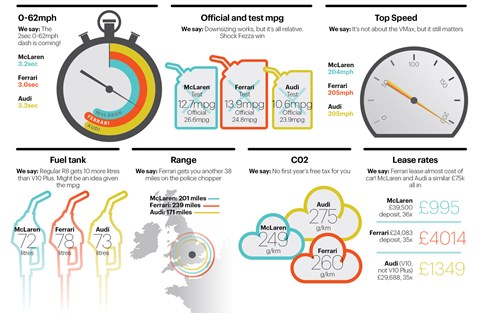
Key tech
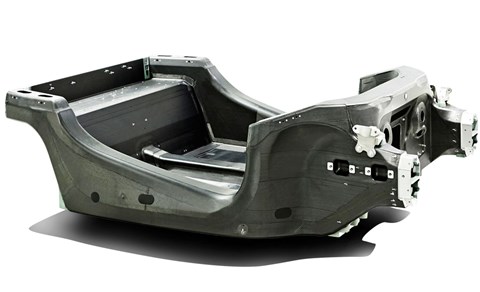
McLaren 570s: Bruv story
The 570S steps on ‘big’ brother 650S’s toes. Both use a carbonfibre MonoCell, 3.8-litre twin-turbo V8, seven-speed dual-clutch ’box, adaptive dampers, Brake Steer in place of an LSD and 19in front/20in rear alloys. Differences? 570S has narrower tyres, uses aluminium, not composite panels, anti-roll bars, not interconnected dampers, and fixed, not active, aero. 570S measures 4530/2095/1202mm and weighs 1313kg dry to the 650S’s – smaller! – 4512/2093/1199mm and 1330kg. 570S: 3.2sec 0-62mph, 650S: 3.0sec. Price? £143k vs £198k.
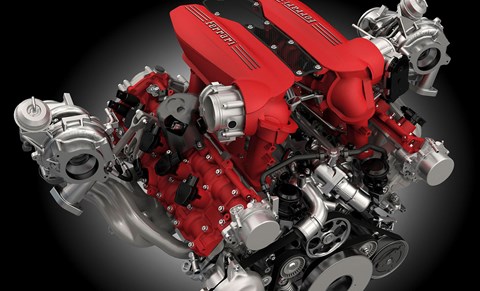
Ferrari 488 GTB: Blow with the flow
How did Ferrari make a turbo engine so responsive? The IHI turbochargers are key, with ball-bearing shafts reducing friction, and lightweight titanium-aluminium alloy compressor wheels quickly spinning up. Variable Torque Management also helps the naturally aspirated feel, drip-feeding torque so the 561lb ft peak arrives at higher revs when you’re driving hard, lower when you’re not.
The 488 GTB’s V8 is related to the California’s, but distantly: 47cc and 500rpm more, new crank, con-rods, pistons, cams, heads and turbos all make the difference.
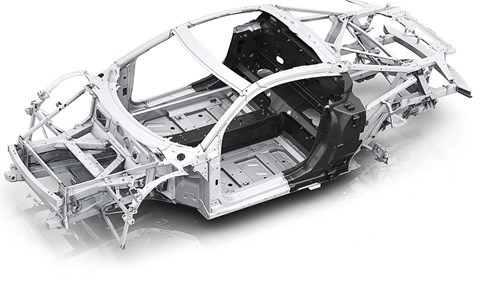
Audi R8: Skeleton’s key
R8 is built around Audi Space Frame. It’s a multi-material mix with a primarily aluminium passenger cell at its core. Carbonfibre, however, forms the transmission tunnel and rear bulkhead. Audi says ASF makes the new R8 50kg lighter and 40% torsionally stiffer than the first generation, but at 1454kg dry it remains the heaviest car on test: the aluminium Ferrari weighs 1370kg, the carbonfibre (with aluminium panels) McLaren 1313kg.
Read more from CAR magazine